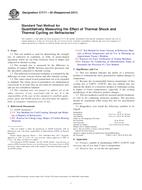Potřebujeme váš souhlas k využití jednotlivých dat, aby se vám mimo jiné mohly ukazovat informace týkající se vašich zájmů. Souhlas udělíte kliknutím na tlačítko „OK“.
ASTM E459-05(2011)
Standard Test Method for Measuring Heat Transfer Rate Using a Thin-Skin Calorimeter
Automaticky přeložený název:
Standardní zkušební metoda pro měření tepla přenosové rychlosti pomocí kalorimetru Thin-Skin
NORMA vydána dne 1.10.2011
Informace o normě:
Označení normy: ASTM E459-05(2011)
Poznámka: NEPLATNÁ
Datum vydání normy: 1.10.2011
Kód zboží: NS-46872
Počet stran: 7
Přibližná hmotnost: 21 g (0.05 liber)
Země: Americká technická norma
Kategorie: Technické normy ASTM
Kategorie - podobné normy:
Anotace textu normy ASTM E459-05(2011) :
Keywords:
calorimeter, convective, heat flux, heat transfer distribution, heat transfer rate, radiative, thin-skin, Calorimeter--aerospace applications, Design--aerospace applications, Heating tests--aerospace materials, Heat transfer, Thin-skin calorimeter, ICS Number Code 17.200.10 (Heat. Calorimetry)
Doplňující informace
| Significance and Use |
|
This test method may be used to measure the heat transfer rate to a metallic or coated metallic surface for a variety of applications, including: Measurements of aerodynamic heating when the calorimeter is placed into a flow environment, such as a wind tunnel or an arc jet; the calorimeters can be designed to have the same size and shape as the actual test specimens to minimize heat transfer corrections; Heat transfer measurements in fires and fire safety testing; Laser power and laser absorption measurements; as well as, X-ray and particle beam (electrons or ions) dosimetry measurements. The thin-skin calorimeter is one of many concepts used to measure heat transfer rates. It may be used to measure convective, radiative, or combinations of convective and radiative (usually called mixed or total) heat transfer rates. However, when the calorimeter is used to measure radiative or mixed heat transfer rates, the absorptivity and reflectivity of the surface should be measured over the expected radiation wavelength region of the source. In 4.6 and 4.7, it is demonstrated that lateral heat conduction effects on a local measurement can be minimized by using a calorimeter material with a low thermal conductivity. Alternatively, a distribution of the heat transfer rate may be obtained by placing a number of thermocouples along the back surface of the calorimeter. In high temperature or high heat transfer rate applications, the principal drawback to the use of thin-skin calorimeters is the short exposure time necessary to ensure survival of the calorimeter such that repeat measurements can be made with the same sensor. When operation to burnout is necessary to obtain the desired heat flux measurements, thin-skin calorimeters are often a good choice because they are relatively inexpensive to fabricate.
|
| 1. Scope |
|
1.1 This test method covers the design and use of a thin metallic calorimeter for measuring heat transfer rate (also called heat flux). Thermocouples are attached to the unexposed surface of the calorimeter. A one-dimensional heat flow analysis is used for calculating the heat transfer rate from the temperature measurements. Applications include aerodynamic heating, laser and radiation power measurements, and fire safety testing. 1.2 Advantages: 1.2.1 Simplicity of Construction—The calorimeter may be constructed from a number of materials. The size and shape can often be made to match the actual application. Thermocouples may be attached to the metal by spot, electron beam, or laser welding. 1.2.2 Heat transfer rate distributions may be obtained if metals with low thermal conductivity, such as some stainless steels, are used. 1.2.3 The calorimeters can be fabricated with smooth surfaces, without insulators or plugs and the attendant temperature discontinuities, to provide more realistic flow conditions for aerodynamic heating measurements. 1.2.4 The calorimeters described in this test method are relatively inexpensive. If necessary, they may be operated to burn-out to obtain heat transfer information. 1.3 Limitations: 1.3.1 At higher heat flux levels, short test times are necessary to ensure calorimeter survival. 1.3.2 For applications in wind tunnels or arc-jet facilities, the calorimeter must be operated at pressures and temperatures such that the thin-skin does not distort under pressure loads. Distortion of the surface will introduce measurement errors. 1.4 The values stated in SI units are to be regarded as standard. No other units of measurement are included in this standard. 1.4.1 Exception—The values given in parentheses are for information only. 1.5 This standard does not purport to address all of the safety concerns, if any, associated with its use. It is the responsibility of the user of this standard to establish appropriate safety and health practices and determine the applicability of regulatory limitations prior to use. |
Podobné normy:
Historická
1.9.2012
Historická
1.3.2011
Historická
1.11.2010
Historická
15.7.2014
Historická
15.9.2013
Historická
1.11.2013



 ASTM C1130-07(2012)..
ASTM C1130-07(2012).. ASTM C1171-05(2011)..
ASTM C1171-05(2011).. ASTM C1371-04a(2010)..
ASTM C1371-04a(2010).. ASTM C1702-14
ASTM C1702-14 ASTM C177-13
ASTM C177-13 ASTM C1784-13
ASTM C1784-13
 Cookies
Cookies
